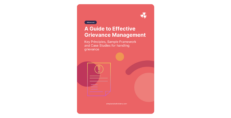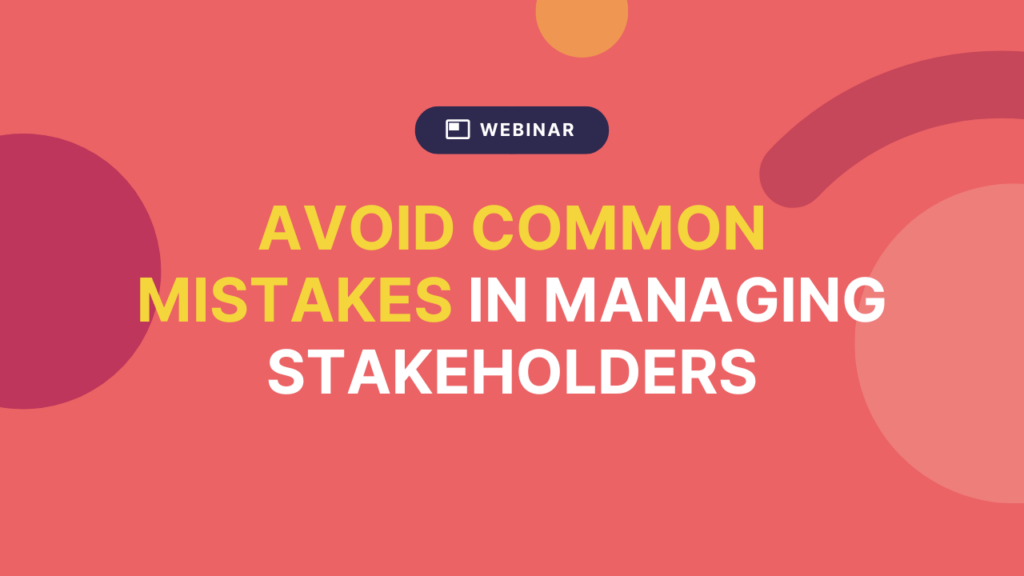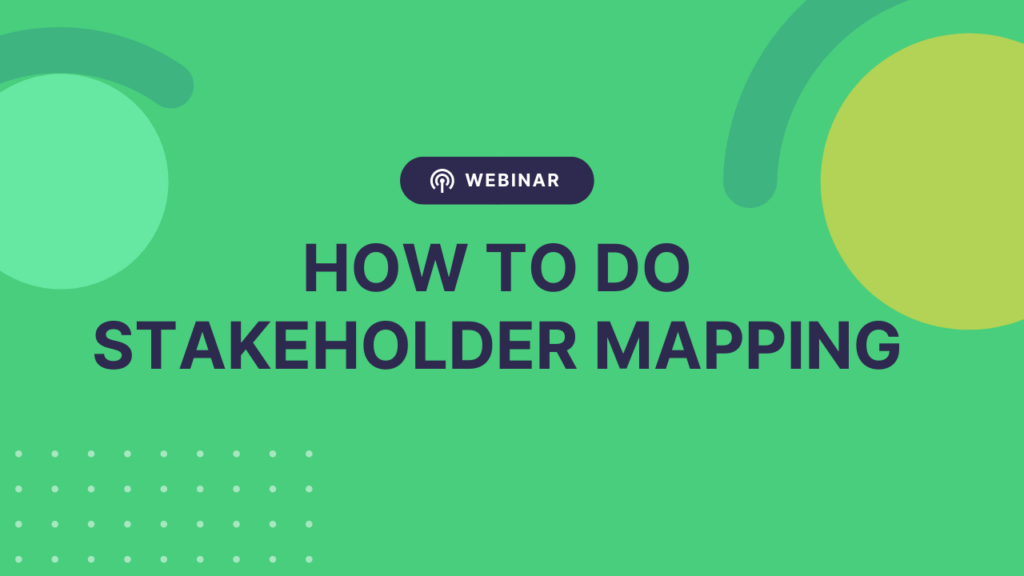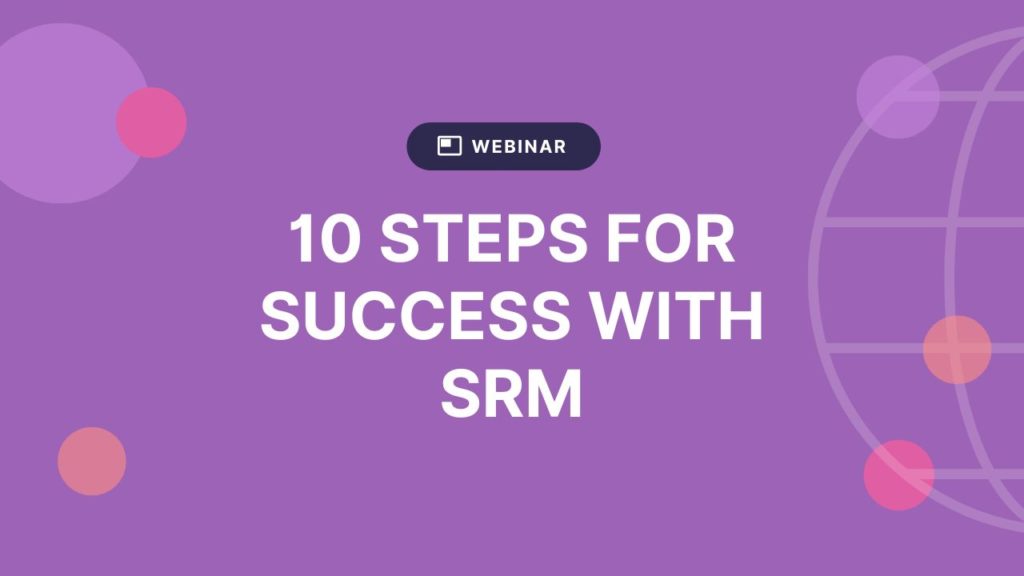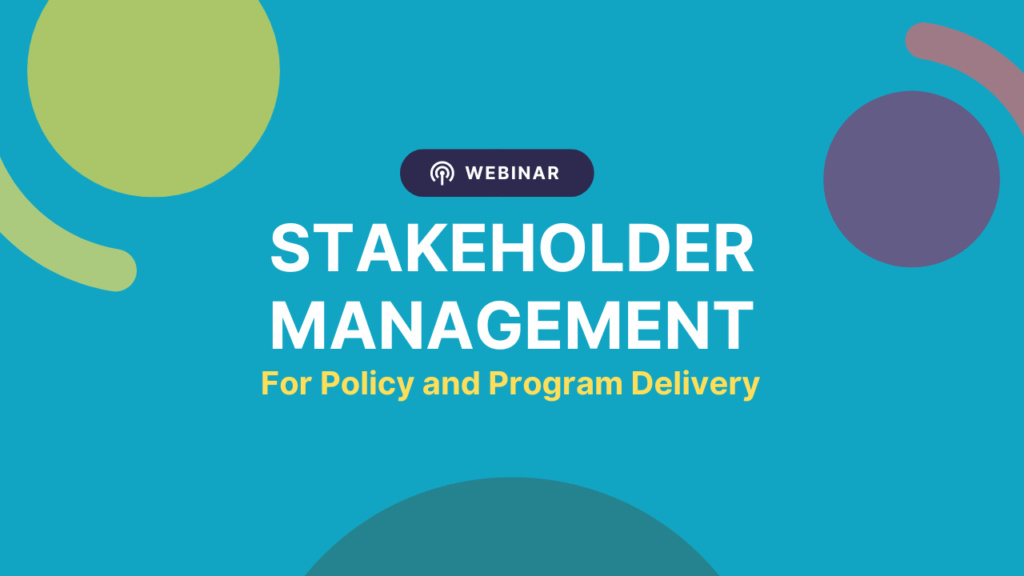Stakeholder Strategy: How to Set Up and Manage Your Plan

Need to create or update your stakeholder strategy? Or curious about how you could take a more strategic approach with your current stakeholder interactions and business activities?
A carefully designed stakeholder strategy will help your team infuse a stakeholder approach into every business process and decision. Plus, create some clear direction from the top-down that will help your whole company coordinate their efforts, work towards the same objectives, and know whether their plans are working.
With a solid strategy, you’ll know where you’re going and how to get there.
So, let’s define what a stakeholder strategy is, how you can create one, and some tips to help you better manage your strategy.
What Is a Stakeholder Strategy?
A stakeholder strategy is a type of business strategy that considers the company’s broader goals and objectives through a stakeholder lens.
While a typical business strategy primarily focuses on creating value for shareholders, the goal of a stakeholder strategy is to create value for the company and a range of company stakeholders. This may include shareholders, customers, suppliers, employees, members of the community, and more.
It is based on stakeholder theory — which suggests that executives should consider the interests of various stakeholders and create value for them, as this increases the sustainability and value of the company.
A stakeholder strategy is not the same as a stakeholder plan, though the process to create them can be similar.
Typically, a stakeholder strategy is more broad, high-level, and long-term, but a stakeholder plan might focus on a specific project with a limited timeline (typically 1-3 years) and covers very specific activities.
Stakeholder strategies are usually developed or owned by the leadership team, while stakeholder plans may be developed by the stakeholder team, project manager(s), or external consultants.
How Do You Create a Stakeholder Strategy?
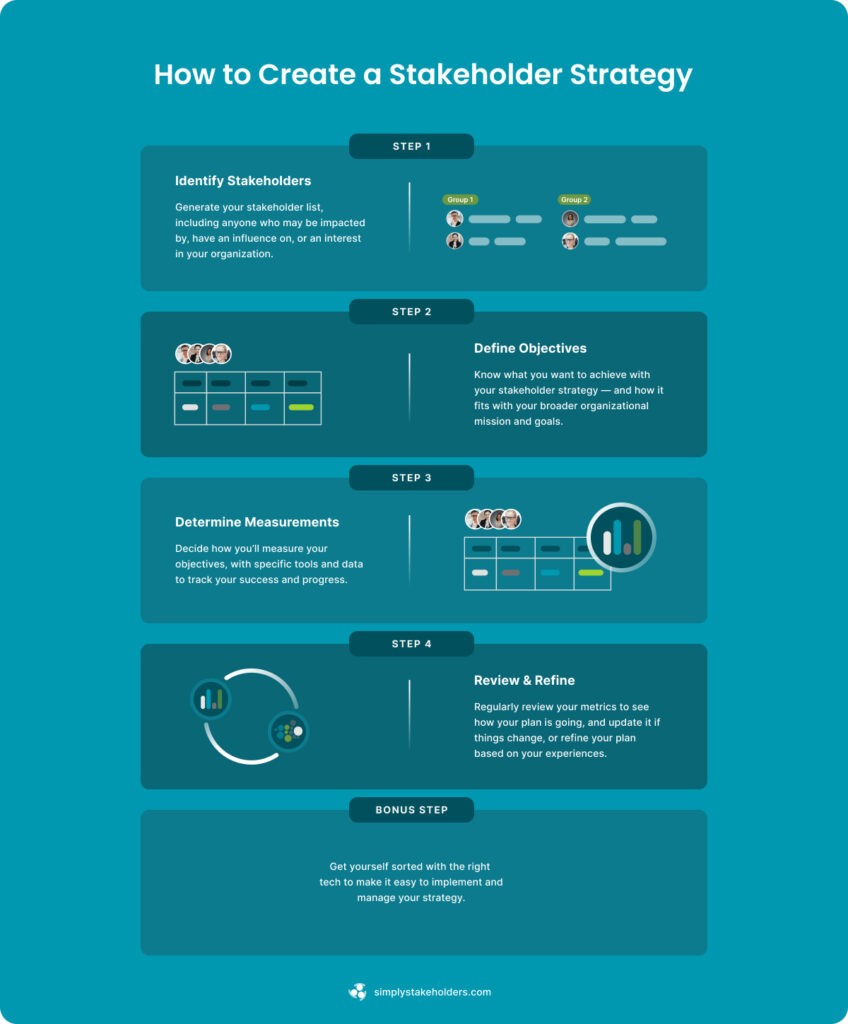
Most organizations can benefit from a detailed, written stakeholder strategy, alongside their other organizational strategies and planning processes.
Unlike a stakeholder engagement strategy for a specific project, your stakeholder strategy isn’t pinned to a specific timeline, so you don’t have to wait for a new project to get started. So to get started, all you need to do is ensure your leadership team can set aside some time to work through the following steps:
Identify Your Stakeholders
You need to know your stakeholders are so that you can begin to identify their needs. So, the first step in creating your stakeholder strategy is stakeholder identification. In other words, you need to create a stakeholder list that encompasses the people, groups, and organizations who:
- May have an influence on your company
- May be impacted by your company
- May have an interest in your company
This is a brainstorming exercise (and each person will likely come up with slightly different answers), so it’s ideal if all the key business leaders in your organization are present to contribute. Encourage people to think broadly, with the goal of “no stakeholder gets left behind!”.
If you already have a stakeholder list, use this opportunity to make some updates. Now might be a great time to consolidate your lists into one master list, as well as updating your list to include your current stakeholders (and exclude anyone who is no longer relevant — along with any stakeholders whose information you need to remove for compliance reasons). Check out more tips in our article on 5 things you can do to improve your stakeholder lists.
If you’ve already created a stakeholder engagement plan for one or more projects, refer to these to get a headstart on identifying your stakeholders. But don’t stop there — your organization may have other stakeholders that weren’t part of your previous projects — so consider any other groups or individuals you may be able to add on to your list.
Define Your Objectives
Another key part of the stakeholder strategy is identifying your objectives.
Firstly, consider the goals and objectives of your organization. What is your mission? What are you hoping to achieve in the coming 3-5 years, 5-10 years, and beyond?
Now, get specific about your stakeholder strategy. Note down how you expect a stakeholder-centric approach to support your company mission, goals, and objectives? What are some specific outcomes you would like to achieve to know that you’ve been successful?
Some examples of objectives include:
- More support from stakeholders
- More frequent communication with stakeholders
- More targeted communication
- More engagement and participation from stakeholders
- Stronger relationships with employees
- More satisfied customers and employees
- Improved reporting processes
- More partnerships and collaborations
- Better resource and information sharing
- Increase influence on industry and policy
Looking for more inspiration for your objectives? Check out these 10 examples of stakeholder engagement objectives and results.
Again, this step is best completed with all your executive business leaders in the room to ensure all key objectives are captured — and to help increase buy-in for the completed strategy.
Determine How You’ll Measure Results
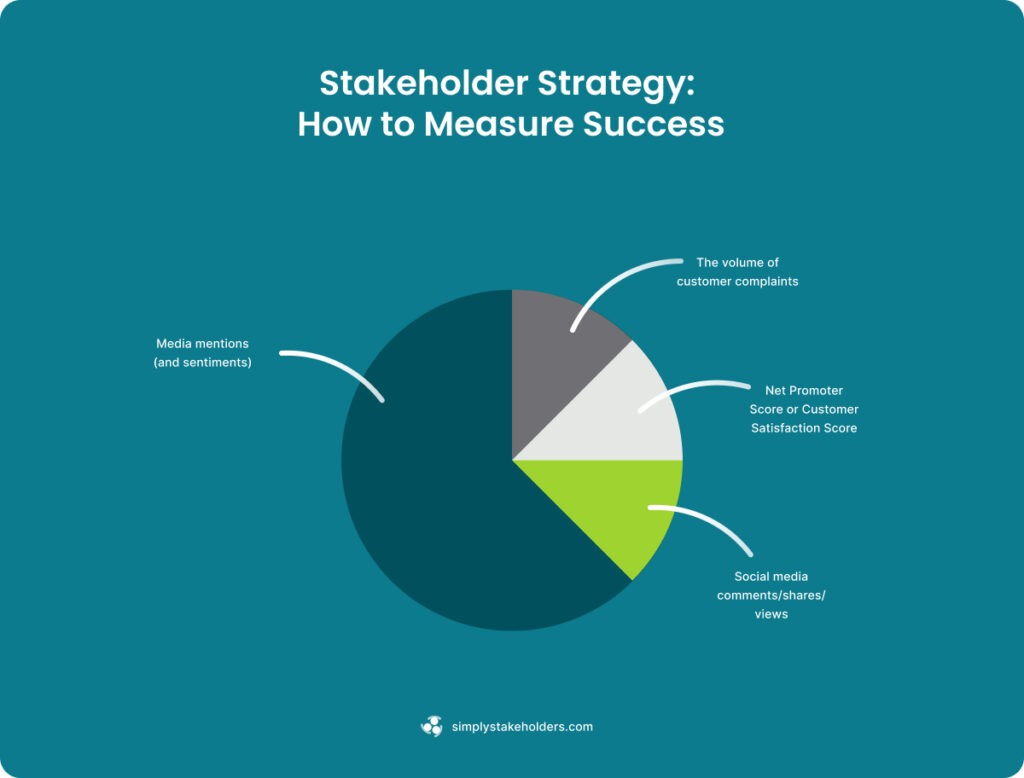
Depending on what objectives you identified, you’ll need to determine the best way to measure whether you’ve successfully achieved those objectives, or not. Some numbers or actions you could track and report on include:
- The volume of customer complaints
- How quickly customer issues are resolved (on average)
- Responsive time to stakeholder queries/requests
- Net Promoter Score or Customer Satisfaction Score
- The number of stakeholders reached each month
- The number of stakeholders that respond to communication/requests for input
- The number of policy working groups participated in during the year (and impact on policies)
- Number of phone or face-to-face interviews
- Number of consultations or meetings with stakeholders
- Focus group attendance and outcomes
- Stakeholder sentiment (as analyzed from transcripts, emails, or survey responses)
- Stakeholder satisfaction (according to survey/interview responses)
- Suggestion box submissions
- Letters sent or received
- Online chat records and ratings
- Social media comments/shares/views
- Engagement rates on social media
- Email open rates, click-thru rates, response rates
- Target audience vs actual audience (according to analytics)
- Diversity, inclusiveness, and representation
- Number of partnerships or alliances
- Number of shared projects/initiatives with partners
- Media mentions (and sentiments)
- Degree of stakeholder influence on decisions (based on stakeholder perceptions or reporting on stakeholder engagement process)
- Social capital (i.e. facilitating new/stronger relationships between stakeholders)
Tip: Stakeholder mapping methods and stakeholder diagrams could be used to track some of these measurements, as well as stakeholder software like Simply Stakeholders.
Some leadership teams may prefer to use the above measurements to break their objectives down into SMART goals. For example, the ‘more satisfied customers and employees’ objective might become the following goals:
- In quarterly customer satisfaction surveys, maintain the average rating of 8/10 (or better)
- Increase employee job satisfaction ratings from 60% to 75% within 18 months
Refine Your Approach
Your stakeholder strategy is ready! Your leadership team should use it to inform your business decisions, to guide your teams, and to help shape the strategic direction of your organization.
But don’t stop there. It’s important to regularly check to see how you’re tracking:
- What results are you getting?
- Is your strategy working?
- Are you achieving your objectives?
Make a regular date to check your strategy (just like you review your other key business strategies) and update it, if needed, based on your results and any changes to your business, your stakeholders, and the business environment. That way, your plan will remain relevant, up-to-date, and a genuinely useful tool for your business and teams. Plus, having a regular checkpoint will also help ensure that your leadership team keeps the stakeholder strategy front of mind.
Use the Right Technology
One more thing — you can create a stakeholder strategy with nothing more than a spreadsheet or word processing software (even pen and paper can do the trick). Some organizations may also use their existing CRM to help manage their stakeholder contacts and communication (at least, to begin with). But there are far better tools that can help you manage your stakeholder strategy, especially if you want to do it efficiently, gain deeper insights, and easily update it as you go along.
When it comes to stakeholder tools, not all are created equal. Features to look for include:
- The ability to store your stakeholder lists (and segment them into groups)
- Detailed stakeholder tracking and contact records
- The ability to analyze and map your stakeholders
- Issues and sentiment tracking
- Integrations (surveys, communication, email, etc.)
- Easy report generation
You won’t find all these features inside a CRM, and certainly not in a spreadsheet. Even powerful tools like Hubspot aren’t suited to stakeholder management. What you really need is purpose-built stakeholder software.
A Simpler Way to Manage Stakeholder Strategy
Ready to start exploring stakeholder software? Simply Stakeholders makes it simple for your team to manage and implement your stakeholder strategy. Easily add and update stakeholder records, sort your contacts into groups, visualize stakeholders with mapping, get AI-driven insights into sentiment, collaborate as a team, and track your progress with reporting. Plus, so much more.
Learn about how Simply Stakeholders works and how stakeholder software can deliver an ROI.















